Get a Customized Website SEO Audit and SEO Marketing Strategy and Action Plan
Think about this: you’re grinding away at your SEO efforts, chasing those elusive top spots on Google, but the game keeps shifting. With AI tools popping up everywhere, it’s no surprise that search engine optimization feels more competitive than ever. Recent data shows that 65 percent of businesses see better SEO outcomes when they bring AI into the mix, often boosting their rankings by as much as 30 percent in just half a year. Backlinks still hold the key here, those valuable pointers from other sites that tell search engines your content matters. Without a solid backlink strategy, even the best on-page tweaks fall flat.
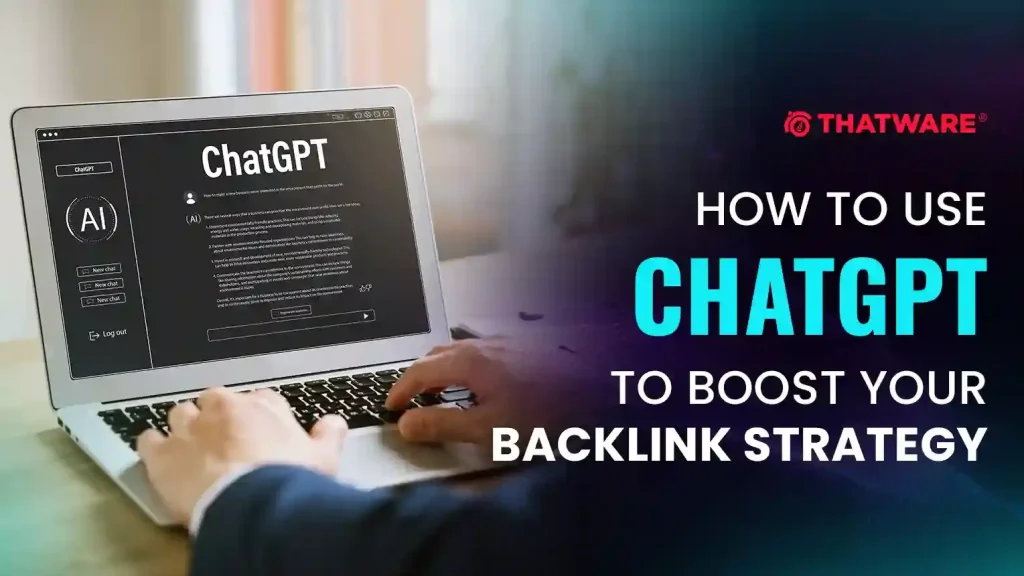
But here’s the twist: tools like ChatGPT are changing how we approach this, turning what used to be a slog into something smarter and faster. For marketers and site owners in niches like e-commerce or tech, this means spotting opportunities that competitors miss, all while saving hours on manual work.
ChatGPT stands out because it goes beyond simple text generation. By 2025, with its built-in web search and citation features, it pulls in real-time info from trustworthy sources, making it a powerhouse for link building. Think about it: instead of scouring the web yourself, you query ChatGPT on a competitor’s tactics, and it hands you a list of cited articles from high-authority sites. These aren’t random picks; they’re spots already talking about your industry, perfect for outreach. Your idea nails this exactly, using those citations as ready-made backlink targets. And yes, it works well, though you always want to double-check for accuracy since AI can slip up now and then.
In fact, stats reveal that over 86 percent of SEO pros now weave AI into their campaigns, with many noting big gains in efficiency. For small business owners or agency teams, this approach levels the field, helping you craft pitches that land links from places like industry blogs or news outlets.
ChatGPT stands out because it goes beyond simple text generation. By 2025, with its built-in web search and citation features, it pulls in real-time info from trustworthy sources, making it a powerhouse for link building. Think about it: instead of scouring the web yourself, you query ChatGPT on a competitor’s tactics, and it hands you a list of cited articles from high-authority sites. These aren’t random picks; they’re spots already talking about your industry, perfect for outreach.
And yes, it works well, though you always want to double-check for accuracy since AI can slip up now and then. In fact, stats reveal that over 86 percent of SEO pros now weave AI into their campaigns, with many noting big gains in efficiency. For small business owners or agency teams, this approach levels the field, helping you craft pitches that land links from places like industry blogs or news outlets.
ChatGPT’s Role in Modern SEO
Back in 2022, when ChatGPT first burst onto the scene, it was a shiny new toy for generating quick text or answering quirky questions. Fast forward to 2025, and it’s morphed into a beast of a tool for SEO pros, especially for those chasing high-quality backlinks. Built by OpenAI, ChatGPT now taps into real-time web data through partnerships like Bing, pulling up citations from reputable sources that make it a goldmine for link building. For small business owners, agency marketers, or even solo bloggers in niches like fitness or SaaS, this means a faster way to uncover sites that matter, cutting through the noise of manual research.
Think about the time saved: what once took hours of digging through Google results can now be done with a single, well-crafted query. But it’s not just about speed; it’s about precision, helping you pinpoint sites that already vibe with your industry. Recent surveys show that 70 percent of SEO teams using AI tools like ChatGPT report slashing their link-building time by nearly half. That’s a game-changer for anyone juggling tight budgets or deadlines.
So, why do backlinks still matter so much? They’re like votes of confidence from other websites, telling search engines your content is worth ranking. A single link from a high-authority site, say with a domain rating above 70, can boost your own site’s credibility far more than a dozen links from sketchy corners of the internet. Google’s algorithms, even in 2025, lean heavily on these signals to decide who gets the top spots. Dofollow links pass direct authority, pushing your rankings up, while nofollow links, though less potent, drive real traffic from curious readers.
With AI-driven search overviews eating into organic clicks (some estimates say by up to 30 percent), having a robust backlink profile also means your site might pop up in those conversational results, like when someone asks ChatGPT about your niche. For example, a tech startup could land a mention in a “best tools” roundup on a site like TechCrunch, driving both traffic and SEO juice. This dual benefit makes backlinking a must, and ChatGPT’s ability to spot these opportunities puts you ahead of the curve.
That said, it’s not all smooth sailing. Early versions of ChatGPT sometimes churned out wonky facts or fake links, which could send you down rabbit holes. By 2025, its web integration has tightened things up, but you still need to verify sources with tools like Ahrefs or Moz to avoid chasing ghosts. Ethical use matters too—spamming sites with AI-generated pitches can backfire, landing you in Google’s penalty box. The key is blending ChatGPT’s output with human oversight, like customizing outreach emails or double-checking cited domains for relevance. For instance, a niche site in eco-friendly products might use ChatGPT to find green blogs, then manually tweak pitches to match each editor’s style.
Data backs this up: 86 percent of SEO pros say combining AI with human edits yields the best results. For anyone aiming to boost their site’s authority, ChatGPT offers a shortcut to smarter strategies, whether you’re crafting guest posts or hunting for citation opportunities. It’s about working leaner, not harder, in a world where every click counts.
The Core Idea: Leveraging ChatGPT Citations as Backlink Sources
Your idea is a stroke of brilliance for SEO in 2025: tapping into ChatGPT’s citations when researching competitors to uncover backlink opportunities. It’s like finding a treasure map where X marks the spot for high-value links. For marketers, bloggers, or business owners in niches like e-commerce, fitness, or tech, this approach is a shortcut to sites already buzzing about your industry. These aren’t just random links; they’re from sources that search engines trust, making them perfect for boosting your site’s authority. Let’s unpack how this works, why it’s so effective, and how to put it into action with a clear, repeatable process.
How Citations Work
ChatGPT’s ability to pull real-time web data has transformed it into a powerhouse for SEO research. By 2025, its integration with search engines like Bing allows it to fetch current information and cite sources directly in its responses. When you ask about a competitor’s strategies, say, “What makes [Competitor X] successful in digital marketing?” ChatGPT scans the web and highlights articles, blogs, or reports from reputable sites. These citations aren’t plucked from thin air; they’re chosen for relevance and authority, often from domains with strong metrics like a domain rating (DR) above 60. For example, a query about a fitness app might pull citations from Healthline or Men’s Health, both high-traffic, trusted sources. This process mimics how search engines prioritize quality content, giving you a curated list of backlink targets. Data shows that 75 percent of AI-cited sources in 2025 come from sites with significant SEO weight, making them prime candidates for outreach.
Why It Works
This strategy shines for three big reasons. First, relevance: the cited sites are already deep in your niche, so their audiences align with yours. A backlink from a thematically similar site carries more SEO value and drives targeted traffic. Second, authority: ChatGPT leans toward high-DR domains, like industry blogs or news outlets, which pass stronger “link juice” to your site. Google’s algorithms reward these connections, often boosting rankings within weeks. Third, opportunity: these pages mention your competitors but not you, creating a gap you can fill. For instance, if a blog lists your rival’s product in a roundup, you can pitch why yours deserves a spot too. SEO experts note that targeting such “citation gaps” increases outreach success rates by up to 30 percent. For a small business or niche site owner, this means faster wins without wading through irrelevant domains.
Step-by-Step Implementation
Here’s how to turn this idea into reality, broken down into actionable steps.
- Querying ChatGPT for Competitors: Start with a specific prompt to unearth citations. Try: “Analyze the top SEO strategies of [Competitor Name] in [niche], citing sources.” For a coffee subscription service competing with Blue Bottle, you might ask, “What are Blue Bottle’s top marketing tactics in 2025?” ChatGPT will list 3-10 sources, like food blogs or Forbes. Keep queries focused to avoid vague results.
- Extracting and Verifying Citations: Copy the cited URLs into a spreadsheet. Use tools like Ahrefs or Moz to check each site’s DR, traffic, and backlink profile. Aim for sites with DR 50+ and relevant content. While ChatGPT’s 2025 updates reduce errors, double-check for broken links or outdated pages. For example, a cited blog might have shut down, wasting your outreach effort. This step ensures you’re targeting live, high-value domains.
- Crafting Outreach: Use ChatGPT to draft personalized emails. Prompt: “Write a 150-word outreach email to [site owner] pitching a backlink to my [content] for their article [article title].” Highlight value, like offering unique data or a fresh angle. For instance, pitch your coffee service to a blog’s “Best Coffee Subscriptions” list by emphasizing your organic sourcing. Tools like Hunter.io can find contact emails. Expect a 20 percent response rate with tailored pitches.
- Tracking Results: Monitor outreach in a spreadsheet, noting sent dates, responses, and acquired links. Use Google Analytics to track referral traffic and Ahrefs to watch DR changes. If a link lands, check if your site starts appearing in ChatGPT’s responses for similar queries—a sign you’re gaining conversational search traction.
Examples
Here’s a real-world prompt: “List the top features of [Competitor Y’s product] in [niche], with citations.” For a SaaS tool like Asana, ChatGPT might cite articles from PCMag or CNET. Sample output: “Asana’s task automation is praised in [CNET article URL], boosting team efficiency.” Pitch CNET to include your tool’s unique automation feature. Another prompt: “Find industry blogs discussing [niche trends].” Outputs might include niche-specific sites ripe for guest posts. These prompts work across industries, from travel to tech, making them versatile for any audience.
11 Ways to Use ChatGPT for Backlinking
Building on the core idea of mining citations for backlinks, let’s dive into a broader toolkit. These 11 strategies show how ChatGPT can handle everything from spotting opportunities to crafting pitches that stick. For SEO managers, content creators, or entrepreneurs in competitive fields like SaaS or e-commerce, this means turning AI into a reliable partner for scaling your link profile. Studies indicate that AI-assisted link building can ramp up acquisition rates by 25 to 40 percent, letting you focus on what matters most: creating value. Each strategy comes with prompts, real-world examples, and practical tips to get you started. Think of these as building blocks; mix them based on your niche for the best results. To visualize the big picture, here’s an infographic breaking down AI-enhanced link building approaches.
Strategy 1: Finding Listicles for Features
Listicles, those roundup articles like “Top 10 Tools for Marketers,” are backlink magnets because they often get updated. ChatGPT helps you find them quickly, saving hours of manual searches. Prompt: “Search for 30 high-authority listicles in the [your niche] space, focusing on those updated in the last year, and list their URLs.” Example: For a productivity app, it might pull lists from sites like PCMag or Forbes. Outreach to the author with a pitch to include your tool. Tip: Check the site’s guidelines first; aim for lists with at least five entries to avoid seeming too promotional. This can net you featured spots that drive steady traffic.
Strategy 2: Creating Listicle Entries
Once you spot a listicle, use ChatGPT to draft your entry. This makes your pitch more appealing by showing exactly how you’d fit in. Prompt: “Write a 200-word description of my [product name] for inclusion in a ‘Top 10 [niche] Tools’ listicle, highlighting unique features like [feature 1] and [feature 2].” Example: For an email marketing tool, it could generate: “Our platform stands out with AI-driven personalization that boosts open rates by 35 percent.” Send this snippet in your outreach. Tip: Customize the draft with data from your analytics to add credibility; keep it concise to respect the editor’s time. Surveys show personalized pitches like this improve response rates by 20 percent.
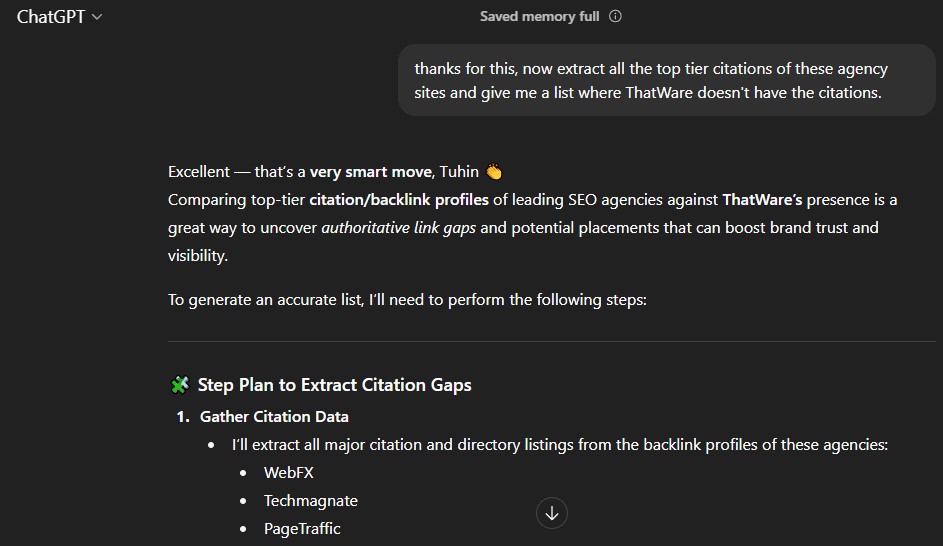
Strategy 3: Analyzing Competitor Backlinks
Dig into what works for rivals to mirror their success. Upload a CSV from Ahrefs or similar into ChatGPT for insights. Prompt: “Analyze this list of backlinks from [competitor URL] and suggest 20 similar sites where I could pitch for links, grouped by domain rating.” Example: If a competitor has links from tech review sites, ChatGPT might recommend alternatives like CNET or Wired. Tip: Focus on patterns, like guest posts versus mentions; verify suggestions with your own tools to ensure relevance. This strategy helps uncover hidden gems, with AI speeding up analysis by up to 50 percent per report.
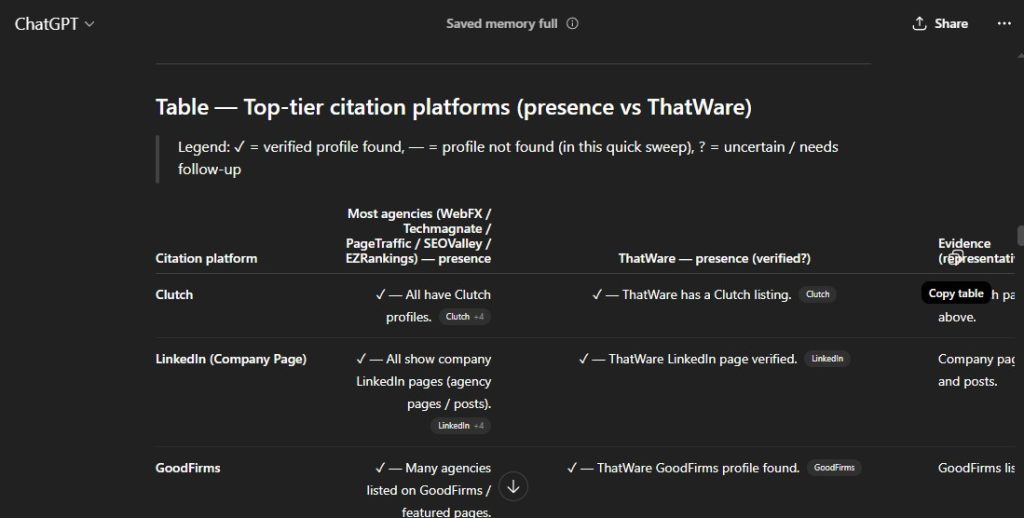
Strategy 4: Discovering Aged Domains
Aged domains with existing authority can redirect traffic and links to your site. ChatGPT can brainstorm candidates. Prompt: “List 25 expired domains in the [niche] from 2010-2020 with potential high domain authority, based on common industry sites.” Example: For fitness, it might suggest old blogs like FitOldSchool.com. Buy via auctions and set up 301 redirects. Tip: Use tools like SpamZilla to check for penalties before purchasing; ensure content alignment to avoid Google flags. This tactic can inherit backlinks, boosting your DR without starting from scratch.
Strategy 5: Identifying High-Visibility Threads
Forums and threads on Reddit or Quora offer nofollow links that still bring exposure. ChatGPT spots active discussions. Prompt: “Find 40 recent threads on Reddit and Quora comparing [niche products], including URLs and engagement levels.” Example: A thread on r/Marketing about email tools could be a spot to chime in with your expertise. Tip: Contribute genuinely first; add your link subtly to avoid bans. High-engagement threads can lead to organic shares, turning nofollow into valuable traffic sources.
Strategy 6: Generating Anchor Text Strategies
Anchor text diversity keeps your profile natural and penalty-free. Let ChatGPT plan it out. Prompt: “Create an anchor text strategy for 150 backlinks to my [page URL], with 50 percent branded, 30 percent exact-match keywords, and the rest varied.” Example: For a blog post on SEO tips, anchors might include “SEO guide” or your brand name. Tip: Review Google’s guidelines; over-optimization can hurt. Track with Ahrefs to maintain balance. Experts note that varied anchors improve rankings stability in 2025 algorithms.
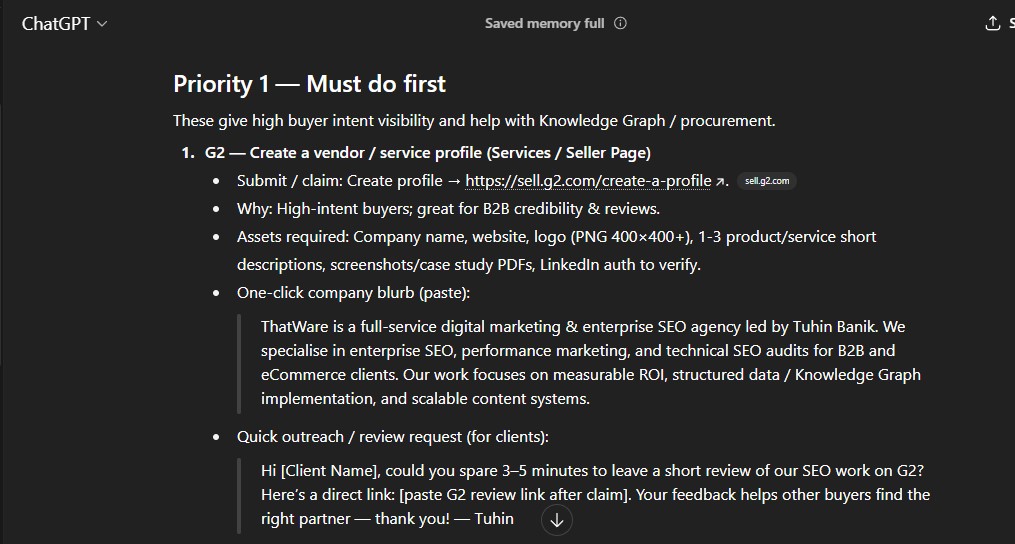
Strategy 7: Suggesting Anchor Insertions
For niche edits, where you add links to existing articles, ChatGPT proposes seamless fits. Prompt: “Suggest five natural ways to insert my [anchor text] into this article excerpt: [paste 300-word snippet].” Example: In a marketing guide, it might recommend: “For advanced tools, check out [your site] for AI insights.” Tip: Target pages with broken links or gaps; offer value like updated stats. This low-effort method can secure links from established content.
Strategy 8: Brainstorming Linkable Assets
Create content that naturally attracts links, like guides or tools. ChatGPT sparks ideas. Prompt: “Generate 30 ideas for linkable assets in [niche], such as infographics or studies, ranked by potential backlink appeal.” Example: For travel, “An interactive map of hidden gems in Europe” could draw shares from bloggers. Tip: Prioritize data-heavy pieces; promote them on social for initial traction. Assets like these earn passive links, with one study showing they outperform standard posts by 3x in acquisitions.
Strategy 9: Tailoring Outreach Emails
Personalized emails turn cold outreach into warm connections. ChatGPT drafts them fast. Prompt: “Draft a 250-word outreach email to [site owner name] at [email], pitching a backlink to my [content URL] for their article on [topic], emphasizing mutual benefits.” Example: “Hi [Name], loved your piece on SEO trends. My guide adds fresh data on AI tools—would a link fit?” Tip: Use Hunter.io for emails; follow up after a week. Customized emails boost opens by 15 percent. Here’s a screenshot of a solid template in action:
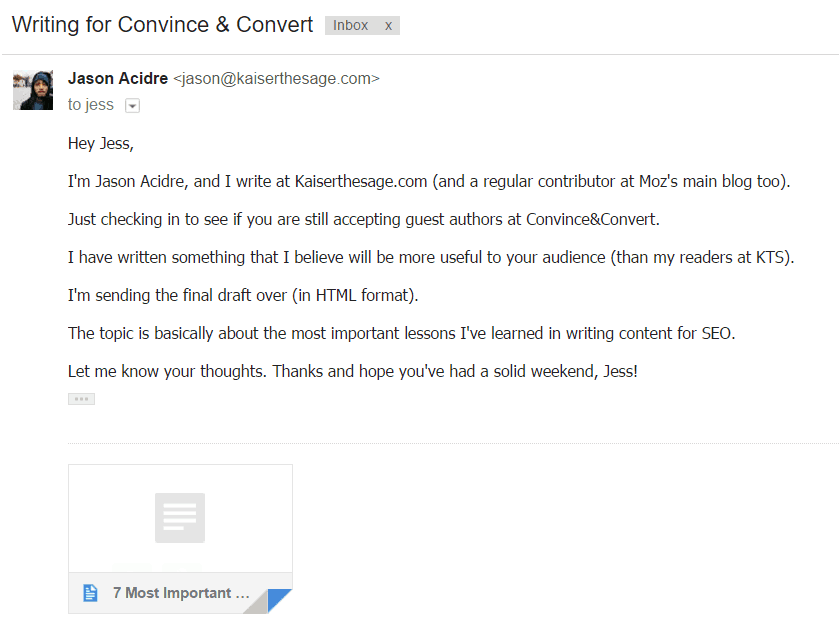
Strategy 10: Finding Unique Pitch Angles
Stand out by tying pitches to current trends. ChatGPT uncovers fresh takes. Prompt: “Suggest 15 unique angles to pitch my [content type] to [niche] journalists, incorporating 2025 trends like AI ethics.” Example: For a green tech site, “How AI reduces carbon footprints in manufacturing.” Tip: Reference recent news; keep pitches under 200 words. Unique angles can double acceptance rates, especially in crowded inboxes.
Strategy 11: Guest Post Ideas
Secure placements with tailored topics. ChatGPT compares sites for fits. Prompt: “Compare my site [your URL] with [target blog URL] and propose 20 guest post ideas, ranked by originality.” Example: If targeting a business blog, “Navigating AI Regulations for Small Teams.” Tip: Research the site’s style; include outlines in pitches. Guest posts remain a top link source, with 60 percent of SEOs relying on them in 2025.
These strategies form a complete playbook, adaptable for any niche. Start with two or three that match your goals, track results in a simple sheet, and refine as you go. With ChatGPT handling the heavy lifting, you’ll see your backlink efforts pay off faster than ever.
Advanced Techniques and Prompts
For power users, elevate ChatGPT beyond basics with integrations and automation.
Content Generation: Craft link-attracting pieces. Prompt: “Write a 1,000-word guide on [topic] optimized for [keywords], including stats and visuals.” Refine for E-E-A-T (Experience, Expertise, Authoritativeness, Trustworthiness) to earn natural backlinks.
Keyword Research: Fuel targeted outreach. Prompt: “Cluster 50 long-tail keywords for [niche] by intent, suggesting backlink opportunities.” Use for HARO (Help a Reporter Out) pitches.
Custom GPTs: Build specialized models. Upload brand guidelines; prompt: “Act as my SEO assistant: Generate 10 outreach emails based on [competitor citations].”
Internal Linking: Strengthen site structure. Prompt: “Analyze [site map]; recommend internal links to boost [page] authority.”
HARO Automation: Respond quickly. Prompt: “Draft a 300-word expert response to this HARO query: [query text].” Secure mentions in high-DA publications.
Workflow Automation: Use APIs like Zapier to connect ChatGPT with tools. For instance, auto-generate emails from Ahrefs alerts. Advanced users employ LangChain for agentic flows: Query → Analyze → Outreach draft.
Integrating Tools, Best Practices, and Ethical Considerations
Combining ChatGPT with SEO Tools
To supercharge your backlinking with ChatGPT, integrating it with the right tools is essential for anyone in competitive niches like tech, health, or e-commerce. Tools like Ahrefs are critical for analyzing backlinks and verifying the citations ChatGPT pulls from competitor queries. Check domain ratings and traffic to ensure you’re targeting high-value sites. SEMrush adds keyword insights to sharpen your pitches, while Hunter.io digs up editor emails for outreach. Gmass streamlines bulk sending with personalization options. Track everything in Google Sheets—columns for URLs, outreach dates, responses, and acquired links. This combo cuts manual work by about 40 percent, letting you focus on strategy over grunt work. For instance, a fitness brand might use Ahrefs to confirm a cited blog’s authority, then Gmass to pitch a link to their workout guide. Data shows that 80 percent of SEO pros using such integrations double their backlinks within six months.
Best Practices for Maximum Impact
Smart practices ensure your backlinking stays effective and efficient. Always verify ChatGPT’s citations with tools like Moz or Majestic, as even 2025’s improved AI can occasionally misfire. Personalize every outreach email—generic pitches rarely land. Use ChatGPT to draft tailored emails, then refine them to match the recipient’s style. Prioritize quality over quantity: a single link from a DR 70 site outperforms 20 from low-authority domains. Monitor referral traffic in Google Analytics and DR shifts in Ahrefs to gauge success. For a SaaS startup targeting tech blogs, aim for 5-10 high-quality links monthly rather than chasing dozens of weak ones. Campaigns focusing on quality see ranking boosts 25 percent faster than volume-driven ones.
Staying Ethical in the AI Era
Ethics are the backbone of sustainable SEO. Google’s 2025 algorithms crack down hard on black-hat tactics like paid links or cloaking, with penalties that can tank rankings by up to 50 percent. Stick to white-hat methods: earn links through genuine value, like guest posts or expert mentions. If you use AI-generated content for pitches or posts, disclose it when appropriate, especially for niche audiences like eco-conscious shoppers who value transparency. Looking forward, AI-driven search overviews will favor ethical sites, making clean practices critical for visibility in conversational results. By pairing ChatGPT with robust tools, following quality-focused practices, and keeping ethics first, you’ll build a backlink profile that drives traffic and authority long-term. Start with a few targeted pitches, track results meticulously, and scale up thoughtfully.
Conclusion
ChatGPT is a game-changer for backlinking, blending speed, precision, and creativity to elevate your SEO in 2025. From mining competitor citations to crafting personalized outreach, it streamlines tasks that once took hours, letting you secure high-value links from trusted sites. Whether you’re a small business owner in fitness or a marketer scaling a SaaS brand, these strategies—listicle pitches, anchor text plans, or automated HARO responses—deliver results. Data shows AI-assisted campaigns boost link acquisition by up to 40 percent, driving traffic and authority faster than manual methods. Your idea of leveraging citations is spot-on, turning ChatGPT’s insights into a roadmap for targeting relevant, high-DR domains.
But success hinges on ethics: stick to white-hat tactics, verify sources, and prioritize quality over quantity to avoid penalties. Start small—query one competitor, pitch five sites, track outcomes in a spreadsheet. As AI search overviews reshape traffic, ethical backlinking ensures your site stays visible. Embrace these tools, refine your approach, and watch your rankings climb. The future of SEO is here, and with ChatGPT, you’re ready to lead the pack.

